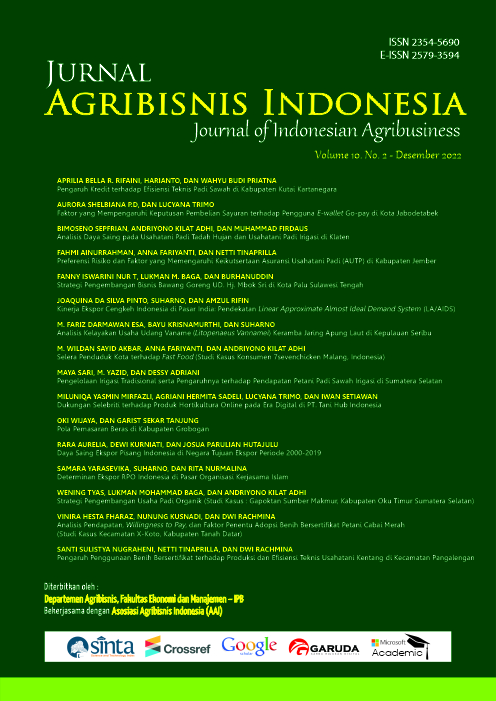Strategi Pengembangan Bisnis Bawang Goreng UD. Hj. Mbok Sri di Kota Palu Sulawesi Tengah
Main Article Content
Abstract
Domestic shallot production generally has met domestic needs. Agricultural development aims to increase the production and income of farmers, especially in Central Sulawesi. One of the mainstay commodities that are expected to increase farmers' income is the local Palu shallot commodity. The purpose of this research is mapping the current business model of UD. Hj. Mbok Sri, analyzing the internal and external conditions of the business and formulating a design for improving its business model. The methods that used in this research are the Business Model Canvas (BMC), SWOT and Blue Ocean Strategy (BOS). This research was conducted by mapping the latest business models based on the 9 elements that exist in BMC, then it will be followed by a SWOT analysis on each BMC element and determining the strategy to overcome the problems that was existing at UD. Hj. Mbok Sri. Then it will be combined for improving the new business model from UD. Hj. Mbok Sri by using Blue Ocean Strategy’s perspective. The results showed that the alternative strategies that could be pursued in the development of UD. Hj. Mbok Sri can be focussed on customer segments elements, value propositions, channels, customer relationships and key partnerships, namely by optimizing the use of social networks, adding new customer segments and increasing the value proposition. These will have effects on better established customer and partnership relationships. Key activities will run smoothly and the main resources will also be more adequate, so that the flow of income will increase and the cost structure can be managed properly.
Downloads
Article Details

This work is licensed under a Creative Commons Attribution 4.0 International License.
Jurnal Agribisnis Indonesia (JAI) is an Open Access Journal. The authors who publish the manuscript in this journal agree to the following terms:
Creative Commons License
JAI is licensed under a Creative Commons Attribution 4.0 International License. This permits anyone to copy, redistribute, remix, transmit, and adapt the work provided the original work and source are appropriately cited.
This means:
(1) Under the CC-BY license, authors retain ownership of the copyright for their article, but authors grant others permission to use the content of publications in Jurnal Agribisnis Indonesia in whole or in part provided that the original work is properly cited. Users (redistributors) of JAI are required to cite the original source, including the author's name, JAI as the initial source of publication, year of publication, volume number, issue, and Digital Object Identifier (DOI); (2) Authors grant JAI the right of first publication. Although authors remain the copyright owner.
References
Bahrudin I, Wahyudi, Ansar M, Sanrang S. 2009. Kajian SOP (Standard Operating Procedure) Sistem Budidaya dan Pasca Panen Bawang Merah Lokal Palu di Sulawesi Tengah. Hibah kompetitip Penelitian Sesuai Prioritas Nasional BATCH II. Laporan Penelitian LPPM Universitas Tadulako. Palu.
[BPS] Badan Pusat Statistik Sulawesi Tengah, 2012. Luas panen, produksi, produktivitas bawang merah Lokal Palu Provinsi Sulawesi Tengah 2012. Diakses melalui https://sulteng.bps.go.id. Pada tanggal 21 maret 2021. Palu: BPS Indonesia.
David, FR. 2011. Konsep Manajemen Strategi. Edisi 12. Jakarta (ID): Salemba Empat.
Euis S, Hubeis S, Maulana A. (2014). Analisis model bisnis pada KNM fish farm dengan pendekatan business model canvass (BMC). Jurnal Sosek KP, 9 (2): 185-194.
Fitriani. (2013). Rentabilitas Usaha pada Industri Bawang Goreng Sal-Han di Kota Palu Sulawesi Tengah. J. Agrotekbis. Vol. 1 (3):1-8. Fakultas Pertanian Universitas Tadulako. Palu.
Haryadi. 1998. Prinsip Manajemen Kontemporer untuk Mengarungi Lingkungan Bisnis. Global Aditya Media. Yokyakarta.
Irawan B. (2003). Agribisnis Hortikultura: Peluang Dan Tantangan Dalam Era Perdagangan Bebas. SOCA 3(2) : 146-160.
Juliana, (2014). Rentabilitas Usaha Industri Bawang Goreng Mahkota di Kecamatan Palu Barat Kota Palu. J. Agrotekbis. 3(1): 1-9.
Kementeriaan Pertanian. 2015. Distribusi Perdagangan Komoditas Bawang Merah Indonesia. Badan Penelitian dan Pengembangan Pertanian. Jakarta (ID). Kementerian Pertanian.
Kim WC, Mouborgne R. 2005. Blue Ocean Strategy: How to Create Uncontested Market Space and Make Competition Irrelevant. Boston (US): Harvard Business School Pr.
Limbongan J, Maskar. (2003). Potensi Pengembangan dan Ketersediaan Teknologi Bawang Merah Palu di Sulawesi Tengah. Jurnal Litbang Pertanian 22 (3): 103-108.
Markides C, Charitou CD. (2004). Competing With Dual Business Models: A Contingency Approach. Academy of Management Executive. 18: 22-36.
Nanong M, Mappatoba M, Howara D. (2017). Rentabilitas Usaha Bawang Goreng Pada CV. Duta Agro Lestari di Kota Palu. Jurnal Agrotekbis 5(3): 377-384.
Osterwalder A, Pigneur Y. 2014. The Business Model Generation: A Handbook for Visionaries, Game Changersand Challengers, John Willey & Sons. Jakarta (ID): PT. Elex Media Komputindo.
Permadi B, Nurmalina R, Kirbrandoko. (2016). Analisis Pengembangan Model Bisnis Kanvas CV. Kandura Keramik Bandung. Jurnal Aplikasi Manajemen (JAM), 14 (1): 88-97.
Rukka MR, Busthanul N, Fatonny N. (2018). Strategi pengembangan bisnis dengan pendekatan business model canvas (Studi Kasus pada CV.OAG di Kota Makassar, Sulawesi Selatan). Jurnal Sosial Ekonomi Pertanian, 14 (1): 41-54.
Veranita, D. 2011. Strategi Pengembangan Usaha Bakso Ikan Tuna, Surimi dan Campuran (Studi Kasus : CV. Bening Jati Anugerah di Bogor) [tesis]. Bogor (ID). Institut Pertanian Bogor.
Wibowo S. 2004. Budidaya Bawang. Jakarta: PT Penebar Swadaya.

